This article was published in Scientific American’s former blog network and reflects the views of the author, not necessarily those of Scientific American
The identity of Earth's first flower has long vexed botanists. The intoxicating, extravagant, and not-to-mention enormous magnolia was long thought to be the poster bloom for the earliest flowering plants, as depicted on many a dinosaur-infested mural.
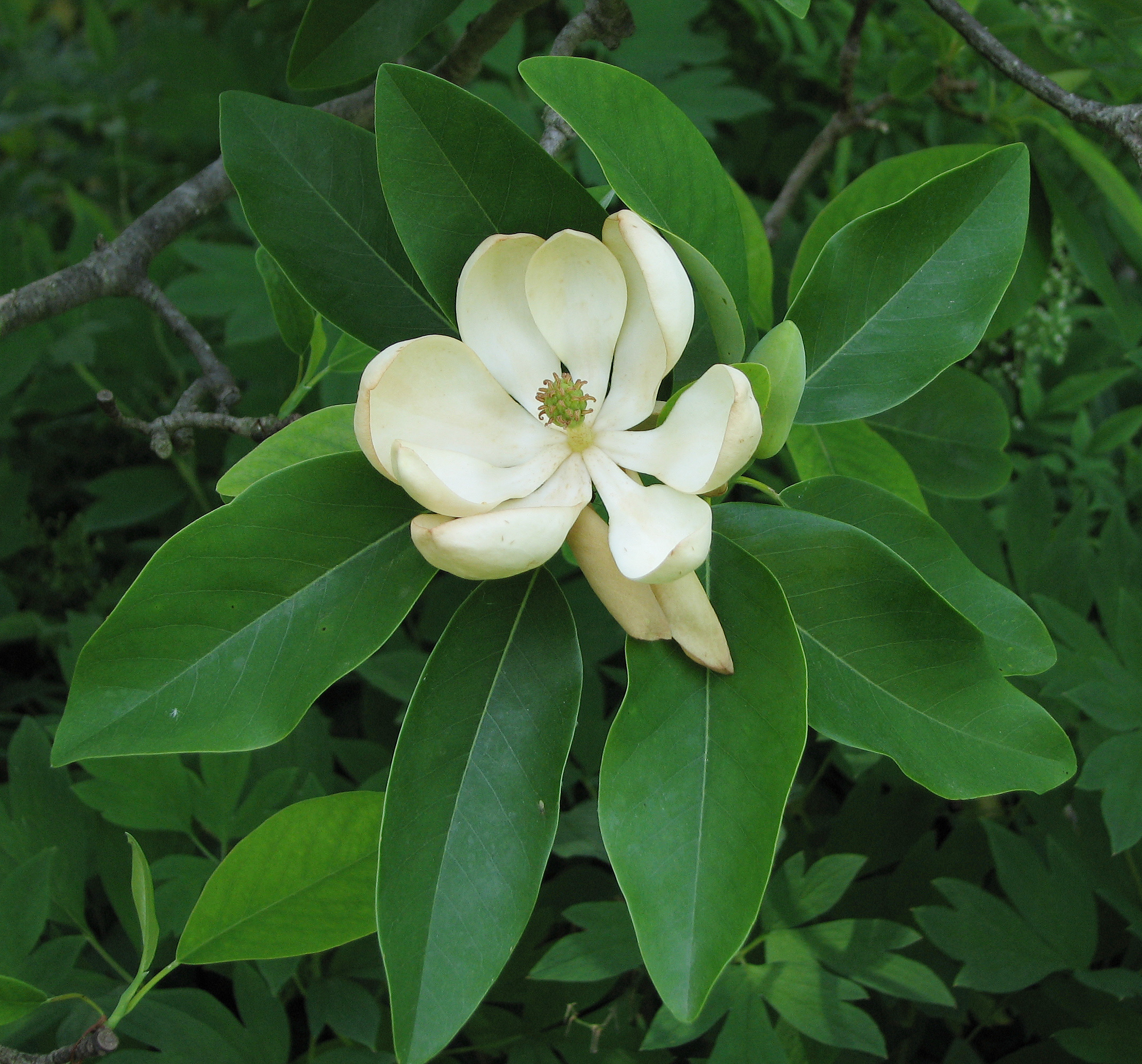
"Sweetbay Magnolia Magnolia virginiana Flower Closeup 2146px" by Photo by and (c)2008 Derek Ramsey (Ram-Man). Co-attribution must be given to the Chanticleer Garden. - Self-photographed. Licensed under CC BY-SA 3.0 via Wikimedia Commons.
Others have suggested the first flowers appeared on shrubs in damp, dark and disturbed forests.
On supporting science journalism
If you're enjoying this article, consider supporting our award-winning journalism by subscribing. By purchasing a subscription you are helping to ensure the future of impactful stories about the discoveries and ideas shaping our world today.
But lately, evidence has been accumulating that leads scientists to suspect the opposite: that the first flowers may have been diminutive, odorless, nectarless, petal-less, aqueous, and pollinator-less -- in short, probably unrecognizable as flowers to any casual human observer. Such a contrary conclusion is surprising, to say the least. But both fossil and molecular evidence seem to suggest this, and the latest fossil to join the parade is Montsechia vidalii:
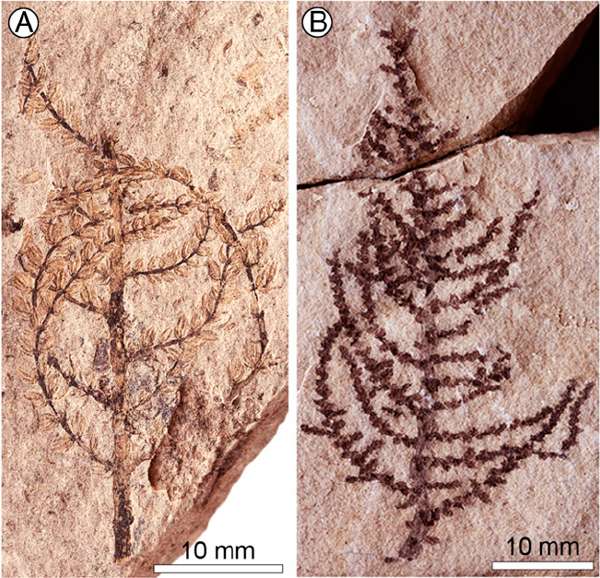
Two specimens of Montsechia vidalii. Fig. 1 from Gomez et al. 2015. Click here for source.
Montsechia was discovered in rocks in Spain's Pyrenees Mountains more than 100 years ago. The rocks date to 125 to 130 million years ago, close to believed born-on date of flowering plants around 130 million to 210 million years ago. Just what Montsechia is has been the subject of great debate.
Suggestions for its identity have ranged from a little moss relative called a liverwort, to tall glassy plants called horsetails, to some sort of gymnosperm (like pines or firs), to a proper flowering plant (formally called Angiosperms).
It lacks roots entirely (not one was found in 1000 fossils) and for some reason, grew in two different forms seen in the two fossils above, and in A and B below.
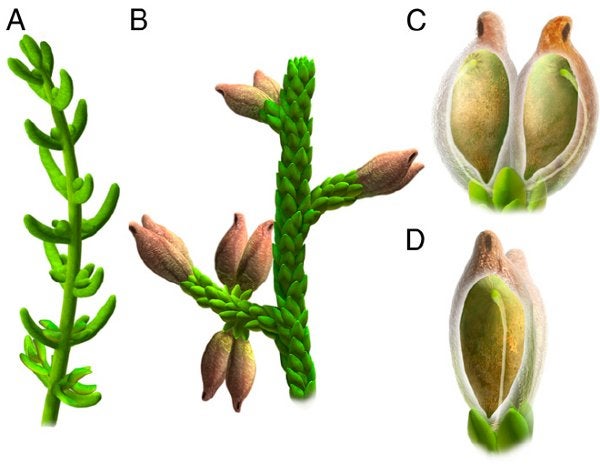
Reconstructions of Montsechia vidalii. Fig. 3 from Gomez et al. 2015. Click here for source.
The two forms have never been found attached to each other. Yet they are always found in about equal proportions in the same rocks.
A team of scientists from France, Germany, Spain, and the United States recently took another look at these fossils and concluded that that they are indeed from a flowering plant, and published their results in PNAS this summer.
What convinced them was the presence of structures that they interpret as fruit. One of the forms has long leaves and rarely makes fruit. The other has short, scaly leaves and makes lots of fruit, mostly in pairs, as you can see above. What makes the scientists so sure the two forms are even the same species? The plants have the same microscopic structure and make the same fruits. Strangely, no male bits have ever been found on either form.
So if the first flowers didn't really appear like flowers to our eyes, what made them flowers? The answer is that fruit. The defining characteristic of a flower is possession of a carpel, usually containing a stigma and style -- the sticky bit that protrudes from the flower to receive pollen -- but at the minimum containing an ovary where eggs are made. Insects pollinate flowers by depositing pollen on the stigma, whence the pollen grains germinate and send out germ tubes that travel down the style to the ovary. Once the eggs there are fertilized, the whole structure becomes seed-containing fruit; a fruit is simply a fertilized and ripened ovary.
"Ovule-Gymno-Angio-en" by derivative work: Qef (talk) Ovule-Gymno-Angio-fr.svg: Original uploader was Tameeria at en.wikipedia. Translation and vectorisation by Cehagenmerak. - Ovule-Gymno-Angio-fr.svg. Licensed under Public Domain via Commons.
The Gymnosperms, the naked seed plants that include ferns and conifers, make seeds only -- no fruit. Earlier evolved plants like mosses and liverworts don't even make seeds – only spores. But Montsechia, apparently alien from everything that says “flower”, turned into a fruit with recognizable bits, at least according to the European team.
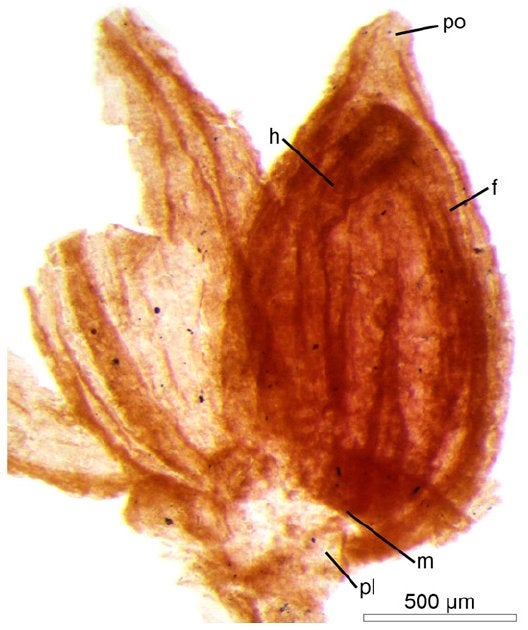
po= pore, f=funicle, h=hilum, pl=placenta, m=micropyle (entrance to ovule)? Fig. 2 from Gomez et al. 2015. Click here for source.
Though it's hard to see in this image, according to them, the seed is contained inside this brown oval fruit, and is suspended upside down from a long funiculum, the plant equivalent of the umbilical cord. At the top, the ovary/fruit wall has a pore that allows pollen to get inside, but the pollen grain's germ tube (if such existed) needed to grow all the way around the ovule to reach its entrance opposite the pore.
The pores and corresponding lack of stigma/style, together with the fact that the flowers are unadorned and single-sex, suggest they were pollinated under water, the scientists say. Pollen-admitting underwater pores today are rare, but not unknown; fewer than 5% of existing aquatic flowering plants employ water pollination.
Montsechia suspiciously similar to a familiar modern plant: Ceratophyllum. You may know this plant because it's common in aquariums.

"Illustration Ceratophyllum demersum0". Licensed under Public Domain via Wikimedia Commons.
Notice the watery milieu, lack of roots, leaf pattern, and fruit in pairs. Most terrestrial plants that later move to water do not shed their terrestrial-style floral stigmas for a pore, or, at least, they bear telltale structures that testify to their time on land, just as some whales have tiny, internal vestigial hip bones. Ceratophyllum bears no such structures, suggesting it's likely that it has always been aquatic, or at least has been so for a very, very long time.
Montsechia also joins Archaefructus which made a splash 10 years ago as another “first flower” candidate as yet another early flowering plant that appears to have been small, humble, and aquatic. And they are not alone. In this family tree of living plants at the origin of the flowering plants, aquatic or possibly aquatically evolved species are colored blue.
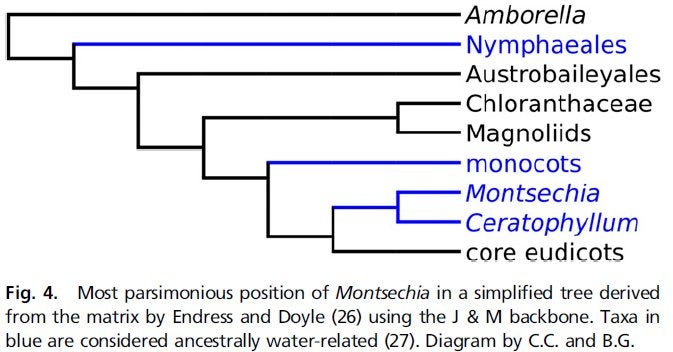
From Gomez et al. 2015. Click here for source.
The water lily family, Nymphaceae, which also appears to have evolved very early, are still aquatic today. And monocots – plants like grasses and lilies with parallel veined leaves -- had ancestors that may have also been aqueous. Bevhalstia pebja, another candidate for the first flower, another candidate for the first flower, also seems to have been small and aquatic.
The magnolias are also still in the mix as very early flowering plants. The current suspect for the earliest evolved surviving flowering plant is Amborella, which today is a woody shrub found only on one island in the Pacific French archipelago of New Caledonia (I wrote about it here). When first evolved, it may or may not have appeared then as it does today.
At one point, based on DNA comparisons, Ceratophyllum, not Amborella, was considered to the be the earliest diverging living flowering plant, the scientists say. Now most analyses support Amborella in that position, though a few still suggest Ceratophyllum.
Certainly Montsechia, eerie doppelganger of Ceratophyllum, appears to have been highly adapted to a watery existence, and it had already done so by a very early stage of flowering plant evolution. Ceratophyllum is unquestionably a flowering plant, so if it and Montsechia indeed related, this would confirm that flowering plants existed by at least 125 million years ago, and continues to hint that the “first flower” have been not perched upon a showy glossy tree, but hidden inside a humble aquatic weed.
Reference
Gomez, Bernard, Véronique Daviero-Gomez, Clément Coiffard, Carles Martín-Closas, and David L. Dilcher. "Montsechia, an ancient aquatic angiosperm." Proceedings of the National Academy of Sciences (2015): 201509241.